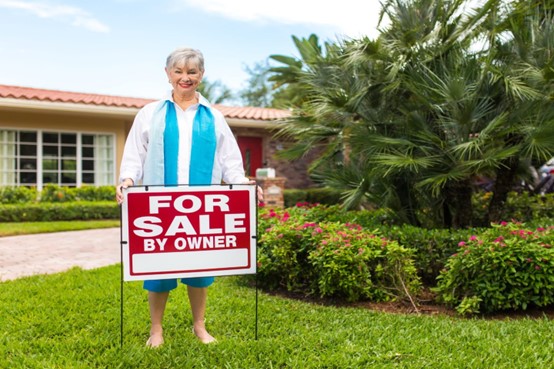
《财富》杂志曾经形容疫情期间历史性的低抵押贷款利率是福祸相依。能够享受到低于市场水平的利率当然是好事,尤其是当两者相差巨大时,但这也会让你被锁定;除非你别无选择,否则你不太可能为了7%的利率而放弃3%的抵押贷款利率。
这种现象被称为“锁定效应”,而在过去的一年里,这种效应已经出现了微妙的缓解迹象。去年,因为没有人出售或购买房屋,现房销售跌至近三十年来的最低点。但卖房人似乎终于做好了准备;唯一的问题是,购房人是否同样积极。Zillow首席经济学家斯凯拉·奥尔森在昨天发布的月度房地产报告中写道:“卖房人正在重返市场,但购房人却变得犹豫不决。”
奥尔森重申:“卖房人开始积极卖房,但购房人却并没有这么热情。”但我们如何得知卖房市场正在复苏? 5月份新挂牌房源增长了约8%,与去年同期相比增长了近13%。奥尔森写道:“尽管大多数未偿还抵押贷款的利率远低于当前的市场利率,随着时间的推移,业主继续持有现有住宅和低利率抵押贷款的‘利率锁定’效应似乎正在减弱。”
但5月份的房屋销量依旧不及去年;根据Zillow的数据,5月销量同比下降了6%。另外,根据Redfin今天发布的一份分析报告,待售房屋销量比去年同期下降了3.5%,这是三个多月以来的最大降幅,其购房者需求指数也下降了18%(自2月份以来的最低值),该指数考虑了看房要求和对Redfin中介提供的其他服务的要求。
奥尔森表示,无论如何,销量下降在一定程度上有助于补充房屋库存:待售房屋数量比去年同期增长了22%(去年同期的待售房屋数量接近历史最低点),总房屋库存也达到了三年来的最小缺口,根据Zillow的数据,这基本上意味着总库存量比疫情之前低约34%,仍有巨大差距。
上个月的竞争并不激烈,因此房价升值有所放缓。4月,房价同比上涨4.4%,但5月仅上涨了3.9%(环比涨幅同样有所下降)。房屋涨价速度放缓对想买房的人来说是件好事,但房价依旧比疫情之前上涨了45%。
奥尔森写道:“Zillow的市场热度指数显示,美国房地产市场对购房人越来越友好,正朝着‘中性’的方向发展,但卖房人仍略占优势。在美国50个最大的都市区中,水牛城、哈特福德和圣何塞对卖房人最有利。而新奥尔良、迈阿密、杰克逊维尔和孟菲斯则对购房人更有利,这些市场中的购房人有更好的谈判筹码。”在全美范围内,将近四分之一的待售房屋降价,这是过去六年来降价房源比例最大的一次。
总而言之,对于想买房的人来说,当前的市场状况大不相同,成本也更高。根据Zillow的数据,按月计算,50个大都市区的房价都在上涨,按年计算,46个大都市区的房价上涨。我们已经知道,自疫情爆发以来,房价大幅上涨,而抵押贷款月供也在上涨。普通抵押贷款的月供比去年高出11.3%,比疫情之前高出115.3%。因此,房地产市场不仅比去年更加昂贵,而且与四年前相比也截然不同。这就不难想象为什么购房人会打退堂鼓。
抵押贷款利率略有下降;日利率为6.97%(因昨天的消费物价指数报告而创下三个月来的最低水平),周利率为6.95%。根据Zillow的数据,房价上涨速度也有所放缓。因此,对于潜在购房人来说,情况或许会开始好转?
Redfin的经济研究负责人陈钊(音译)在分析报告中表示:“尽管本周的美联储会议会抑制抵押贷款利率的下降,最新的通胀报告对购房者来说是好消息,因为它已经使抵押贷款利率下降。但从另一方面来看,如果抵押贷款利率下降带来的需求大于供给,这可能会消除房价上涨放缓的可能性,并进一步推高房价。就购房者的月供而言,利率下降和房价上涨最终可能会相互抵消。”
但Zillow的奥尔森写道,如果说有什么变化的话,那就是房地产市场正在朝着某种平衡的方向发展。(财富中文网)
翻译:刘进龙
审校:汪皓
《财富》杂志曾经形容疫情期间历史性的低抵押贷款利率是福祸相依。能够享受到低于市场水平的利率当然是好事,尤其是当两者相差巨大时,但这也会让你被锁定;除非你别无选择,否则你不太可能为了7%的利率而放弃3%的抵押贷款利率。
这种现象被称为“锁定效应”,而在过去的一年里,这种效应已经出现了微妙的缓解迹象。去年,因为没有人出售或购买房屋,现房销售跌至近三十年来的最低点。但卖房人似乎终于做好了准备;唯一的问题是,购房人是否同样积极。Zillow首席经济学家斯凯拉·奥尔森在昨天发布的月度房地产报告中写道:“卖房人正在重返市场,但购房人却变得犹豫不决。”
奥尔森重申:“卖房人开始积极卖房,但购房人却并没有这么热情。”但我们如何得知卖房市场正在复苏? 5月份新挂牌房源增长了约8%,与去年同期相比增长了近13%。奥尔森写道:“尽管大多数未偿还抵押贷款的利率远低于当前的市场利率,随着时间的推移,业主继续持有现有住宅和低利率抵押贷款的‘利率锁定’效应似乎正在减弱。”
但5月份的房屋销量依旧不及去年;根据Zillow的数据,5月销量同比下降了6%。另外,根据Redfin今天发布的一份分析报告,待售房屋销量比去年同期下降了3.5%,这是三个多月以来的最大降幅,其购房者需求指数也下降了18%(自2月份以来的最低值),该指数考虑了看房要求和对Redfin中介提供的其他服务的要求。
奥尔森表示,无论如何,销量下降在一定程度上有助于补充房屋库存:待售房屋数量比去年同期增长了22%(去年同期的待售房屋数量接近历史最低点),总房屋库存也达到了三年来的最小缺口,根据Zillow的数据,这基本上意味着总库存量比疫情之前低约34%,仍有巨大差距。
上个月的竞争并不激烈,因此房价升值有所放缓。4月,房价同比上涨4.4%,但5月仅上涨了3.9%(环比涨幅同样有所下降)。房屋涨价速度放缓对想买房的人来说是件好事,但房价依旧比疫情之前上涨了45%。
奥尔森写道:“Zillow的市场热度指数显示,美国房地产市场对购房人越来越友好,正朝着‘中性’的方向发展,但卖房人仍略占优势。在美国50个最大的都市区中,水牛城、哈特福德和圣何塞对卖房人最有利。而新奥尔良、迈阿密、杰克逊维尔和孟菲斯则对购房人更有利,这些市场中的购房人有更好的谈判筹码。”在全美范围内,将近四分之一的待售房屋降价,这是过去六年来降价房源比例最大的一次。
总而言之,对于想买房的人来说,当前的市场状况大不相同,成本也更高。根据Zillow的数据,按月计算,50个大都市区的房价都在上涨,按年计算,46个大都市区的房价上涨。我们已经知道,自疫情爆发以来,房价大幅上涨,而抵押贷款月供也在上涨。普通抵押贷款的月供比去年高出11.3%,比疫情之前高出115.3%。因此,房地产市场不仅比去年更加昂贵,而且与四年前相比也截然不同。这就不难想象为什么购房人会打退堂鼓。
抵押贷款利率略有下降;日利率为6.97%(因昨天的消费物价指数报告而创下三个月来的最低水平),周利率为6.95%。根据Zillow的数据,房价上涨速度也有所放缓。因此,对于潜在购房人来说,情况或许会开始好转?
Redfin的经济研究负责人陈钊(音译)在分析报告中表示:“尽管本周的美联储会议会抑制抵押贷款利率的下降,最新的通胀报告对购房者来说是好消息,因为它已经使抵押贷款利率下降。但从另一方面来看,如果抵押贷款利率下降带来的需求大于供给,这可能会消除房价上涨放缓的可能性,并进一步推高房价。就购房者的月供而言,利率下降和房价上涨最终可能会相互抵消。”
但Zillow的奥尔森写道,如果说有什么变化的话,那就是房地产市场正在朝着某种平衡的方向发展。(财富中文网)
翻译:刘进龙
审校:汪皓
Fortune once called the historically low mortgage rates of the pandemic era a blessing and a curse. It’s true—there’s nothing better than a below-market rate, especially when there’s such a substantial difference, but it keeps you locked in, too; it’s hard to give up a, let’s say, 3% mortgage rate for a 7% one, unless you have no other choice.
It’s a phenomenon called the lock-in effect, and all year it has shown subtle signs of easing. Last year, existing home sales fell to their lowest point in almost three decades because nobody was selling or buying homes. But it seems sellers are finally ready; the only thing is, buyers aren’t matching their energy. “Home sellers are returning to the market but finding buyers hesitating,” Zillow’s chief economist Skylar Olsen wrote in a monthly housing report published yesterday.
“Buyers aren’t matching sellers’ uptick in activity,” Olsen reiterated. But how do we know sellers are making a comeback? New listings rose roughly 8% in May and close to 13% from a year earlier. “The effects of ‘rate lock,’ owners holding on to their existing homes and low-rate mortgages, appear to be lessening over time, even as most outstanding mortgages have a rate well below what’s currently being quoted on the market,” she wrote.
Still, there were fewer sales in May than last year; they were down 6%, according to Zillow. Separately, according to a Redfin analysis published today, pending home sales are down 3.5% from a year earlier, which is the biggest decline in more than three months, and its homebuyer demand index, which considers requests for tours and other services from Redfin agents, is down 18% (the lowest since February).
Either way, Olsen said, the drop in sales volume helped with a sort of housing restock: The number of homes for sale rose 22% from a year earlier, when it was near an all-time low, and total inventory is at its smallest deficit in three years—which basically means it’s still a ways away from pre-pandemic levels, about 34% less, per Zillow.
Competition wasn’t as intense last month, so home price appreciation cooled. In April, home values rose 4.4% from a year earlier, but in May, they rose 3.9% (the monthly increase was lower, too). Slower home price appreciation is great for anyone who wants to buy a home, but home prices are still 45% higher than they were before the pandemic.
“Zillow’s Market Heat Index shows the nation is becoming a bit friendlier for buyers and is headed toward ‘neutral’ territory, but sellers still hold a slight advantage,” Olsen wrote. “Buffalo, Hartford, and San Jose are the top markets for sellers among the 50 largest metro areas. New Orleans, Miami, Jacksonville, and Memphis are all tilted toward buyers, giving those in the market better leverage in negotiations.” And nationally, almost a quarter of homes for sale slashed prices, which is the greatest share in the past six years.
All in all, it’s a much different, more costly landscape for people who want to buy homes. On a monthly basis, home prices are up in all 50 major metropolitan areas, and on an annual basis, they’re up in 46 metros, per Zillow. We already know home prices are considerably higher since the start of the pandemic; monthly mortgage payments are, too. The typical monthly mortgage payment is 11.3% higher than last year, and ready for this—115.3% since before the pandemic. So not only is the housing world more costly than last year, it’s a completely different entity from four years ago. It’s not hard to imagine why buyers are backing off.
Mortgage rates have come down a bit; daily rates are at 6.97% (their lowest in three months on the back of yesterday’s consumer price index report), and weekly rates are at 6.95%. Home price appreciation has slowed as well, according to Zillow. So maybe things will start to look up for would-be buyers?
“The latest inflation report is good for homebuyers because it has already sent mortgage rates down, though this week’s Fed meeting will temper mortgage-rate declines,” Redfin’s economic research lead Chen Zhao said in the analysis. “But on the other side of the coin, if lower mortgage rates bring back more demand than supply, that could erase the possibility that home-price growth softens, and push prices up even further. Lower rates and higher prices may ultimately cancel each other out when it comes to homebuyers’ monthly payments.”
Still, if anything, the housing world is moving toward a balance of sorts, Zillow’s Olsen wrote.






